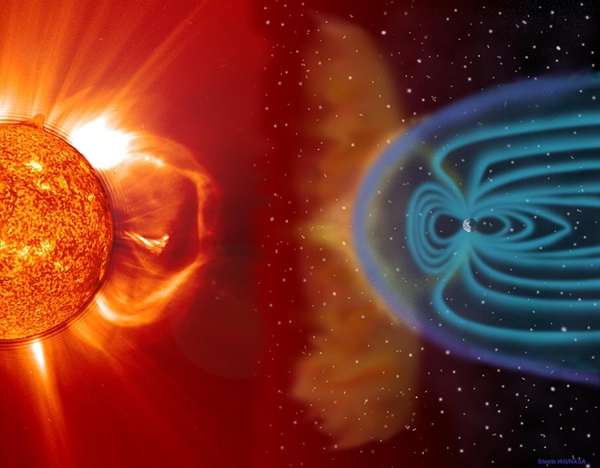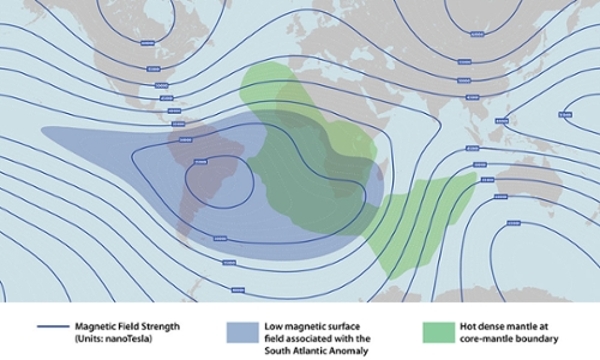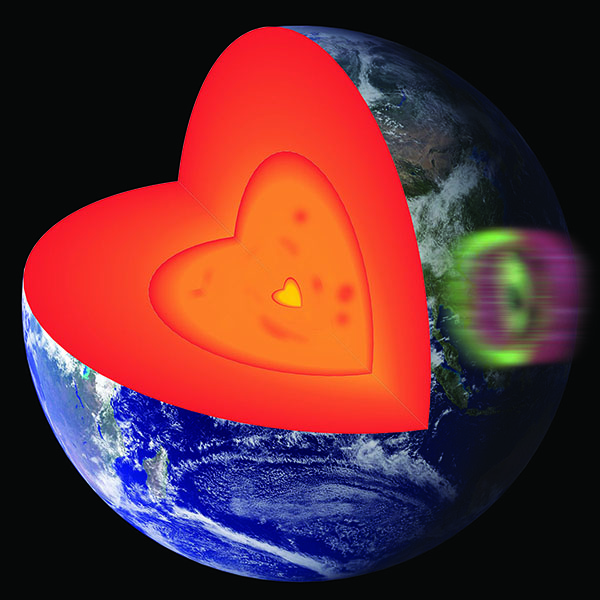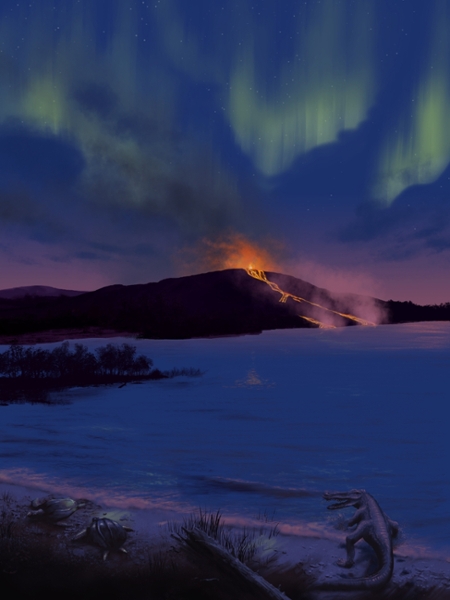Current Projects
First Billion Years of the Geodynamo

The onset and nature of the geomagnetic field is important for understanding the evolution of the core, atmosphere and life on Earth. The geomagnetic field is generated in the liquid outer core, and hence is a probe of core conditions. The field also protects Earth from energetic particles streaming from the Sun (the "solar wind"); without this protective shield Earth might have developed into a dry and barren planet. A record of the early core geodynamo that generated the field is preserved in ancient silicate crystals from igneous rocks that contain minute magnetic grain inclusions. Our data indicate the presence of a geodynamo between 3.4 and 3.45 billion years ago, near the limit for the start of growth of the solid inner-core. While the magnetic field sheltered Earth's atmosphere from erosion at this time, the standoff of the solar wind was greatly reduced, and similar to that seen during modern extreme solar storms. These conditions suggest that intense radiation from the young Sun may have modified the atmosphere of the young Earth by promoting loss of light elements and water. Such effects would have been more pronounced if the field were absent prior to 3.45 billion years ago, as suggested in some hypotheses, or if an older geodynamo prior to inner core growth produced a weak field. In general, these considerations suggest the young Earth was more water-rich than today. The new frontier to learn more about these issues is obtaining geomagnetic field records that are more than 3.45 billion-years-old.
We are investigating the first billion years of geodynamo history and its implications for Earth evolution through the study of well-dated rock units from 6 ancient cores of continents (cratons). We are using a combination of existing methods of single silicate crystal magnetic measurements from in situ igneous host rocks and new approaches involving magnetic analyses of grains from sedimentary units. These measurements are achievable using highly sensitive magnetometers at the University of Rochester. Determination of the presence and strength of the geomagnetic field during the first billion years of Earth history is of broad interest to a range of scientists who study early Earth environments (atmosphere and biosphere) and the core. The investigation involves international collaboration with geologists from several countries, and multidisciplinary collaborations spanning astrophysics and space physics. Our program also integrates research and educational efforts. The study is contributing to graduate theses and undergraduates are receiving training in the field and the laboratory.

Archeomagnetism of Southern Africa: Implications for Longevity of the South Atlantic Anomaly
A broad low intensity area in Earth's recent magnetic field spans the southern Atlantic Ocean, Africa and South America. This is commonly called the South Atlantic Anomaly (SAA). The SAA allows a relatively close approach of Earth's radiation belts, affecting spacecraft operations. The low magnetic intensity decreases the efficiency of magnetic shielding in the region, which can influence atmospheric ozone. Many believe the SAA is linked to the dramatic decay of the dipole geomagnetic field intensity during the last 160 years, and the growth of an area of reversed magnetic field on Earth's core beneath South Africa. Some have even speculated Earth is heading toward a geomagnetic field reversal. But understanding these phenomena within the context of longer-term geomagnetic history has been limited by a lack of Southern Hemisphere archeomagnetic data (that is, data from archeological objects that were fired to high temperature and subsequently preserved a record of Earth's magnetic field as they cooled). Our research and education program is aimed at understanding the history of the geomagnetic field in the SAA region as recorded in southern Africa. The main focus of the work is the collection and subsequent analysis of archeomagnetic data from Iron Age burnt structures, and tests of models addressing how the nature of the boundary between Earth's core and mantle may be giving rise to recent changes seen in the geomagnetic field.
Archeomagnetic data from Iron Age sites of southern Africa (ca. 1000-1650 AD) show a sharp intensity drop at 1300 AD, at a rate comparable to modern field changes in the present-day South Atlantic Anomaly (SAA), but to lower values. The recurrence of low field values may reflect magnetic flux expulsion from the core promoted by the unusual core-mantle boundary composition and structure beneath southern Africa defined by seismology (specifically the African Large Low Velocity Seismic Province, or LLVSP). Because the African LLVSP is a longstanding structure, this region might be a steady site of flux expulsion, and perhaps the triggering site for geomagnetic reversals, on time scales of millions of years. If correct, this conceptual model is transformative because it suggests reversals do not initiate at random locations, but instead nucleate at core-mantle boundary sites that promote flux to leak upward. The model predicts modulation of the field on time scales of the lifetime of an eddy in the core flow, and will be tested by extending the archeomagnetic record of Iron Age southern Africa. The research program is integrated with undergraduate and graduate education and will be conducted with geologists and archeologists from South Africa, Botswana, and Zimbabwe.

The nature of the Ediacaran to early Cambrian geomagnetic field
The suggestion that the entire solid Earth rotated by 90 degrees, approximately 565 million years ago, and that this event sparked the explosion of life on the planet (when most existing animal phyla and classes first appeared), is one of the most controversial hypotheses in the geosciences. Ultimately, the veracity of this idea rests on how well the past geomagnetic field is recorded in ancient rock samples (the purview of the discipline of paleomagnetism). The PIs have developed a method for obtaining paleomagnetic data from geologic samples - known as the single silicate crystal approach - having higher fidelity than standard procedures. Preliminary data applying this method leads the team to an alternative hypothesis. Rather than recording a rotation of the entire solid Earth, the data reflect a geomagnetic field 565 million years ago that was in an unusual state: it was weak, and the poles reversed frequently. The team will test their hypothesis through a single silicate crystal paleomagnetic study of samples from three areas of southern Canada. Because the strength of the geomagnetic field is a principal factor defining shielding of the planet from the solar wind, this study will also help constrain the potential influence of energetic solar particles on the atmosphere and biosphere during this critical time in Earth history. The data collected will also be useful for testing if continental plate velocities were higher than uniformitarian assumptions, in the past. The work will support graduate students and undergraduates, who will acquire valuable skills though training in the classroom, field studies and in the laboratory.
The suggestion that the entire solid Earth rotated by 90 degrees during Ediacaran to early Cambrian times (approximately 635-530 Ma), and that this sparked the early Cambrian explosion of life, is highly contentious. This is not a question of whether such an event, known as inertial interchange true polar wander (IITPW), is theoretically possible, but rather whether it occurred. Ultimately, the veracity of the event relies on the fidelity of paleomagnetic data. The PI team has recently examined this enigma using single silicate crystal paleomagnetic analysis, a method that allows the isolation of single-domain magnetic carriers that are the best field recorders, capable of preserving remanences on billion-year time scales. In their study of the Sept-Iles (approximately 565 Ma) intrusion (Canada), they have not found support for IITPW. Instead, they find evidence that the geomagnetic field was reversing during cooling of the intrusion. Preliminary analyses further suggest unusually low paleointensities. These observations provide the basis for an alterative hypothesis: the Ediacaran to early Cambrian geomagnetic field was unusually weak, and reversed frequently. The team will study three areas in southern Canada to test their hypothesis. This work will also broadly constrain the boundary conditions for biotic evolution during the key Ediacaran to early Cambrian interval, and will have implications for the core, mantle and surface environment. Specifically,the investigators hope to constrain i. whether the geodynamo was in an unusual state (perhaps associated with inner core growth), ii. if the magnetopause standoff distance was reduced, allowing greater penetration of energetic solar particles, and iii. if continental plate velocities were higher than uniformitarian assumptions. The work will support graduate students and undergraduates, who will acquire valuable skills though training in field studies in southern Canada and in the laboratory. They will combine field excursions, classroom studies and summer programs to give students a comprehensive research experience.

Ultra-warm Arctic 90 million years ago
The geologic history of the Arctic region records past climatic conditions that can provide insight into modern conditions and the potential for future change. The focus of this proposed work is on an excursion within the Cretaceous greenhouse world to ultra-warm conditions, approximately 90 million years ago. Evidence for both high temperature and anomalous CO2 volcanic outgassing is found in the geology of the High Arctic. The former comes in the form of a spectacular assemblage of vertebrate fossils found on Axel Heiberg Island, including large-bodied crocodile-like champsosaurs, turtles and fish. The latter is inferred by the presence of continental flood basalts and the Alpha-Mendeleev Oceanic Ridge; these features may form one of Earth's most voluminous large igneous provinces. Multidisciplinary studies in the High Arctic improve understanding of the absolute age and paleotemperatures associated with the vertebrate fossils (carbon and oxygen isotope analyses) and the absolute age and duration of the anomalous volcanism (radiometric age and paleomagnetic analyses). With these data, we can test prior interpretations calling for high mean annual temperatures without seasonal ice, and whether contemporaneous pulses of volcanic activity could have contributed to the inferred warming by altering atmospheric CO2.
